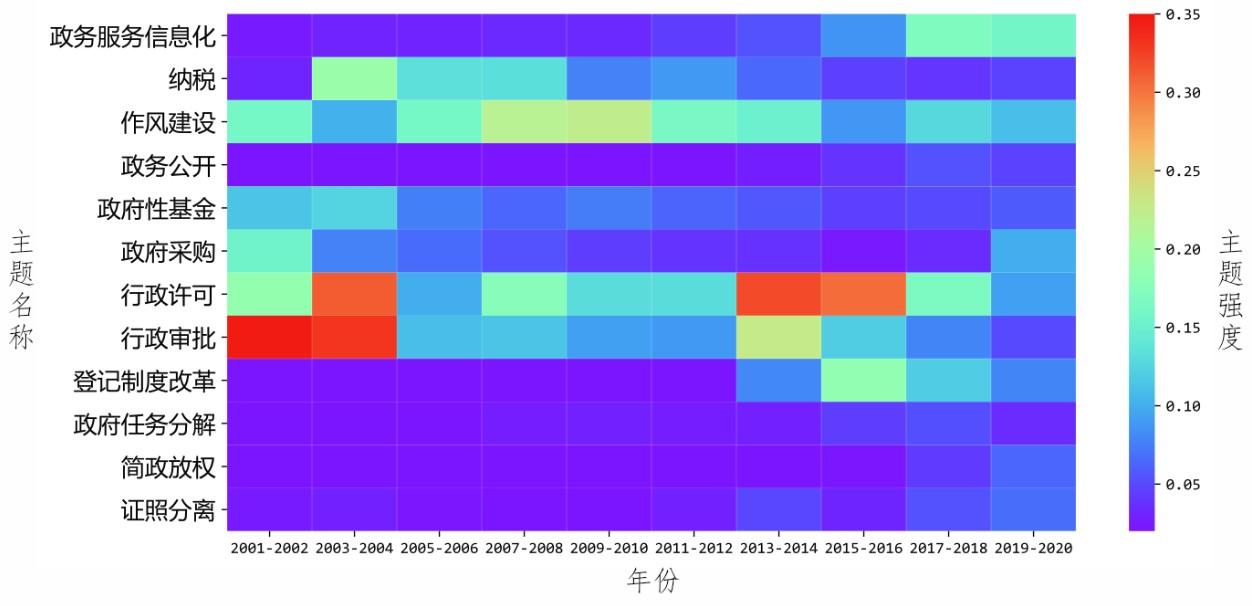 PDF(3134 KB)
PDF(3134 KB)


 PDF(3134 KB)
PDF(3134 KB)
 PDF(3134 KB)
PDF(3134 KB)
营商环境政策的主题演化研究
Research on the Topic Evolution of Business environment policies
[目的/意义]明确我国营商环境政策发展态势,揭示政策重点的时序演化规律,为后续政策的制定与完善提供数据支撑。[方法/过程]基于2001-2020年中央及各地方政府发布的营商环境政策文本,以两年为一个时间片,通过动态主题模型得到30个营商环境主题的时序演化分布,然后将主题归纳到市场环境、政务环境、人文环境和法律环境4个维度下,进而研究营商环境政策中各维度的主题强度及重点发展趋向。[结果/结论]营商环境政策主要集中于政务环境和市场环境建设,政策力度分配不均,且各维度强度在不同经济地区下差异显著,由此针对营商环境政策提出的建议包括:强化市场导向,减弱政务干预,引入法制规范,等等。
[Purpose/Significance] Clarifying the development trend of China's business environment policies, and revealing the time-series evolution law of the policy priorities are to provide data support for the formulation and improvement of subsequent policies. [Method/Process] Based on the business environment policy texts issued by the central and local governments from 2001 to 2020, with two years as a time slice, this article extracted time series evolution distribution of 30 business environment topics through the dynamic topic model, and summarized the topics were into the four dimensions of market environment, government environment, humanistic environment and legal & policy environment, and then analyzed the theme intensity and key development trends of each dimension in the business environment policy. [Result/Conclusion] The result shows that, business environment policies mainly focuses on the construction of government environment and market environment, the distribution of policy strength is unbalanced, and the intensity of each dimension varies significantly in different economic regions. The resulting recommendations for business environment policies include: strengthening the market orientation, weakening government intervention, regulating the legal system, and so on.

business environment policy / text mining / dynamic topic model / topic evolution
| [1] |
The World Bank. Doing business 2020[M]. Washington: World Bank Group, 2019.
|
| [2] |
郑新曼, 董瑜. 政策文本量化研究的综述与展望[J]. 现代情报, 2021, 41(2): 168-177.
|
| [3] |
顾雪芹, 李育冬, 余红心. 长江三角洲地区营商环境政策举措与效果评价[J]. 中国流通经济, 2020, 34(6): 86-95.
|
| [4] |
李雨峰, 陈伟. 优化营商环境下政府在知识产权保护中的职能[J]. 知识产权, 2020(7): 14-25.
|
| [5] |
张守文. 新发展格局与“发展型法治”的构建[J]. 政法论丛, 2021(1): 3-13.
|
| [6] |
赖先进. 哪些优化营商环境政策对经济增长影响更有效?——基于全球162个经济体的证据[J]. 中国行政管理, 2020(4): 145-152.
|
| [7] |
钱玉文. 我国法治化营商环境构建路径探析——以江苏省经验为研究样本[J]. 上海财经大学学报, 2020, 22(3): 138-152.
|
| [8] |
GRIMMER J, STEWART B M. Text as data: the promise and pitfalls of automatic content analysis methods for political texts[J]. Political analysis, 2013, 21(3): 267-297.
|
| [9] |
闫盈盈. 基于DTM模型的政府公文公告主题研究[J]. 中国管理信息化, 2020, 23(21): 151-155.
|
| [10] |
盛东方, 尹航. 基于政策文本计算的突发公共事件下中小企业扶持政策供需匹配研究——以新冠肺炎疫情为例[J]. 现代情报, 2020, 40(8): 10-19.
|
| [11] |
陈玲, 段尧清. 我国政府开放数据政策的实施现状和特点研究:基于政府公报文本的量化分析[J]. 情报学报, 2020, 39(7): 698-709.
|
| [12] |
杨慧, 杨建林. 融合LDA模型的政策文本量化分析——基于国际气候领域的实证[J]. 现代情报, 2016, 36(5): 71-81.
|
| [13] |
杨锐, 杨亮, 李良强, 等. 我国科研诚信政策特征及演化逻辑——基于文本挖掘法[J]. 科技进步与对策, 2020, 37(20): 89-98.
|
| [14] |
张宝建, 李鹏利, 陈劲, 等. 国家科技创新政策的主题分析与演化过程——基于文本挖掘的视角[J]. 科学学与科学技术管理, 2019, 40(11): 15-31.
|
| [15] |
裴雷, 孙建军, 周兆韬. 政策文本计算:一种新的政策文本解读方式[J]. 图书与情报, 2016(6): 47-55.
|
| [16] |
胡税根, 吴逍弛, 李超. 我国优化营商环境政策研究[J]. 领导科学论坛, 2020(23): 31-42.
|
| [17] |
朱晓喆, 马强. 优化营商环境视野下动产让与担保的法律构造及效力——结合《民法典》相关规则的解释[J]. 云南社会科学, 2021(2): 1-11,187.
|
| [18] |
REYNOLDS C, ROHLIN S M. Do location based tax incentives improve quality of life and quality of business environment?[J]. Journal of regional science, 2014, 54:1-32,
|
| [19] |
CEPEL M, STASIUKYNAS A, KOTÁSKOVÁ A, et al. Business environment quality index in the SME segment[J]. Journal of cryptology, 2018, 10(2): 21-40.
|
| [20] |
刘哲, 张海冰. 中国31个省级行政区营商环境评价报告[J]. 国际融资, 2019(1): 12-17.
|
| [21] |
张三保, 康璧成, 张志学. 中国省份营商环境评价:指标体系与量化分析[J]. 经济管理, 2020, 42(4): 5-19.
|
| [22] |
HOLLIBAUGH G E. The use of text as data methods in public administration: a review and an application to agency priorities[J]. Journal of public administration research and theory, 2019, 29(3): 474-490.
|
| [23] |
QUINN K M, MONROE B L, COLARESI M, et al. How to analyze political attention with minimal assumptions and costs[J]. American journal of political science, 2010, 54(1): 209-228.
|
| [24] |
BLEI D M, NG A Y, JORDAN M I. Latent dirichlet allocation[J]. Journal of machine learning research, 2003, 3: 993-1022.
|
| [25] |
WANG X, MCCALLUM A. Topics over time: a non-markov continuous-time model of topical trends[C]. New York: Association for Computing Machinery, 2006: 424–433.
|
| [26] |
BLEI D M, LAFFERTY J D. Dynamic topic models[C]//Proceedings of the 23rd international conference on Machine learning, New York: Association for Computing Machinery, 2006: 113–120.
|
| [27] |
张永安, 马昱. 基于R语言的区域技术创新政策量化分析[J]. 情报杂志, 2017, 36(3): 113-118.
|
| [28] |
李月. 突发公共卫生事件中公共政策主题演化研究——以国家中心城市官方微信为例[J]. 情报杂志, 2020, 39(9): 143-149.
|
| [29] |
岳丽欣, 刘自强, 胡正银. 面向趋势预测的热点主题演化分析方法研究[J]. 数据分析与知识发现, 2020, 4(6): 22-34.
|
| [30] |
RÖDER M, BOTH A, HINNEBURG A. Exploring the space of topic coherence measures[C]//Proceedings of the eighth ACM international conference on Web search and data mining. Shanghai:ACM,2015: 399-408.
|
| [31] |
齐亚双, 祝娜, 翟羽佳. 基于DTM的国内外情报学研究主题热度演化对比研究[J]. 图书情报工作, 2016, 60(16): 99-109.
|
| [32] |
CHAKRABORTY S, VENKATARAMAN A, JAGABATHULA S, et al. Predicting socio-economic indicators using news events[C]//Proceedings of the 22nd ACM SIGKDD international conference on knowledge discovery and data mining. San Francisco:ACM,2016: 1455–1464.
|
| [33] |
谭春辉, 熊梦媛. 基于LDA模型的国内外数据挖掘研究热点主题演化对比分析[J]. 情报科学, 2021, 39(4): 174-185.
|
| [34] |
刘沫茹, 刘奕彤. 中国地方政府优化营商环境的功能定位及建设路径[J]. 中国发展, 2020, 20(3): 29-35.
|
| [35] |
MIKOLOV T, SUTSKEVER I, CHEN K, et al. Distributed representations of words and phrases and their compositionality[C]//Proceedings of the 26th international conference on neural information processing systems- Volume 2. New York: Curran Associates Inc.,2013: 3111–3119.
|
| [36] |
王帅. 法治、善治与规制——亲清政商关系的三个面向[J]. 中国行政管理, 2019(8): 99-104,150.
|
| [37] |
席龙胜, 万园园. 营商环境优化促进创新的机制及其异质性研究[J]. 经济纵横, 2021(11): 52-60.
|
| [38] |
葛新权. 基于知识管理的广义营商环境建设与保障[J]. 知识管理论坛, 2021, 6(3): 127-133.
|
| [39] |
我国东西中部和东北地区划分方法[J]. 统计与咨询, 2012(6): 63.
|
| [40] |
董彪, 李仁玉. 我国法治化国际化营商环境建设研究——基于《营商环境报告》的分析[J]. 商业经济研究, 2016(13): 141-143.
|
刘勘:负责选题指导、论文的撰写与修订
赵帅:数据资料的搜集、实验设计及论文撰写
彭虎锋:研究思路的指导,论文修订
黄漫宇:论文修订与逻辑梳理
/
| 〈 |
|
〉 |